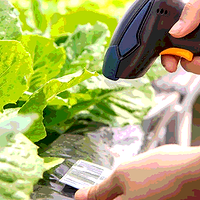A Deeper Dive into Interoperability: Exploring the Flow of Data in the Seafood Supply Chain

We often take technology for granted in the way that it works seamlessly for us to communicate across distances. We can transition our video calls from our desktops to our phones with little effort. Multiple family members’ laptops and devices tap into the household wi-fi each day within seconds.
It’s this “plug-and-play” interoperability that helps keep the flow of information moving in our daily lives, and there is strong evidence that this type of efficiency can contribute to a safer food system. When trading partners’ systems can easily and quickly transmit consistent information throughout the supply chain, foods are more traceable in the event of a crisis. For the supply chain to become more seamlessly digitized and efficient enough to serve the needs of today’s consumers and protect them from potentially harmful products, higher levels of interoperability must be promoted within the food system.
As part of a deeper dive into the challenges associated with data sharing in the food supply chain, GS1 US recently teamed up with 12 seafood industry stakeholders to conduct a pilot that explores enhanced data sharing in the supply chain. The study was conducted by GS1 US in collaboration with the Global Dialogue on Seafood Traceability (GDST), Institute of Food Technologists (IFT), Beaver Street Fisheries, Bumble Bee Seafoods, Chicken of the Sea, FoodLogiQ, IBM Food Trust, Insite Solutions/Norpac, ripe.io, SAP, Walmart, and Wholechain.
The following are three takeaways from the study that indicate the importance of interoperability to support food safety evolution.
1. A standards-based framework is essential.
The pilot, completed in June, leveraged a successful 2020 prototype confirming that traceability solutions from FoodLogiQ, IBM Food Trust, ripe.io, Envisible, and SAP can interoperate to transmit and exchange information about a product’s journey throughout the supply chain. It established that GS1 Standards were necessary to identify products, entities, locations, critical tracking events, and key data elements to support the interoperability of systems.
Specifically, GS1 Standards were vital to these two requirements for interoperability:
1. Globally unique identification, such as the use of Global Trade Item Numbers (GTINs) for products and and Global Location Numbers (GLNs) for identifying entities and locations.
2. Standardized data models and APIs for sharing data across platforms. This includes a GS1 Standard called EPCIS (Electronic Product Code Information Services) helped capture and share event-based data and effectively connect the traceability systems involved.
GS1 US also worked with GDST and the seafood industry trading partners to test the flow of data using GDST 1.0 standards, which are already trusted, specific application standards that specify the data and event requirements for the seafood industry. While GS1 Standards helped give the participant systems the ability to “speak” to each other, the industry collaboration adding GDST application standards was equally critical to define what is being “said” or shared within the network and how.
2. Diverse technologies must interoperate—not just blockchain.
The pilot successfully demonstrated how technical standards can help industry achieve interoperability among diverse traceability systems. While blockchain is a specific technology choice for some traceability platforms supporting food safety use cases, traceability is also possible using cloud or other emerging technology systems.
A key motivator for studies like these is to bring attention to the data being shared across the food system. It’s important to remember that any one solution does not inherently make the data being shared more trustworthy—bad data can be recorded on a blockchain too, for example. A single solution also does not, by itself, provide end-to-end supply chain visibility. To achieve a truly visible and traceable supply chain, the integration of internal and external business processes must occur. This means that the internal processes a company uses to track a product within its operation is integrated into a larger system of external data exchange and business processes that take place between trading partners to move the product. Therefore, to solve whatever supply chain challenge has been identified—in this case, seafood traceability—the focus must really be on the network of trading partners sharing data and then trusting in that data via the audit trail of those transactions.
3. Interoperability is core to FSMA traceability rule readiness.
The interoperability of these systems also supports possible future requirements of the U.S. Food and Drug Administration’s (FDA) proposed Food Safety and Modernization Act, Section 204 Food Traceability Rule. Though it won’t be finalized until 2022, the proposed rule and comment period have already sparked a strong sense of urgency among the entire food community to leverage more digital, tech-enabled traceability systems now. The FDA’s strong endorsement of the use of electronic data exchange over more manual methods of sharing supply chain data (PDFs, spreadsheets, paper documents) represents an opportunity to modernize our systems and ensure they can work together to align with consumer expectations for delivering safe products and removing suspect products quickly.
Ultimately, interoperability is critical for the food system to become more flexible and resilient to change. It allows for enhanced data exchange and the necessary speed and efficiency needed to keep up with consumer demands. Exploring interoperability through studies like these provides us with the intelligence to move forward as a more collaborative and coordinated supply chain, equipped with more consistent data to keep consumers safe.
Angela Fernandez is vice president of community engagement at GS1 US.
Looking for a reprint of this article?
From high-res PDFs to custom plaques, order your copy today!






